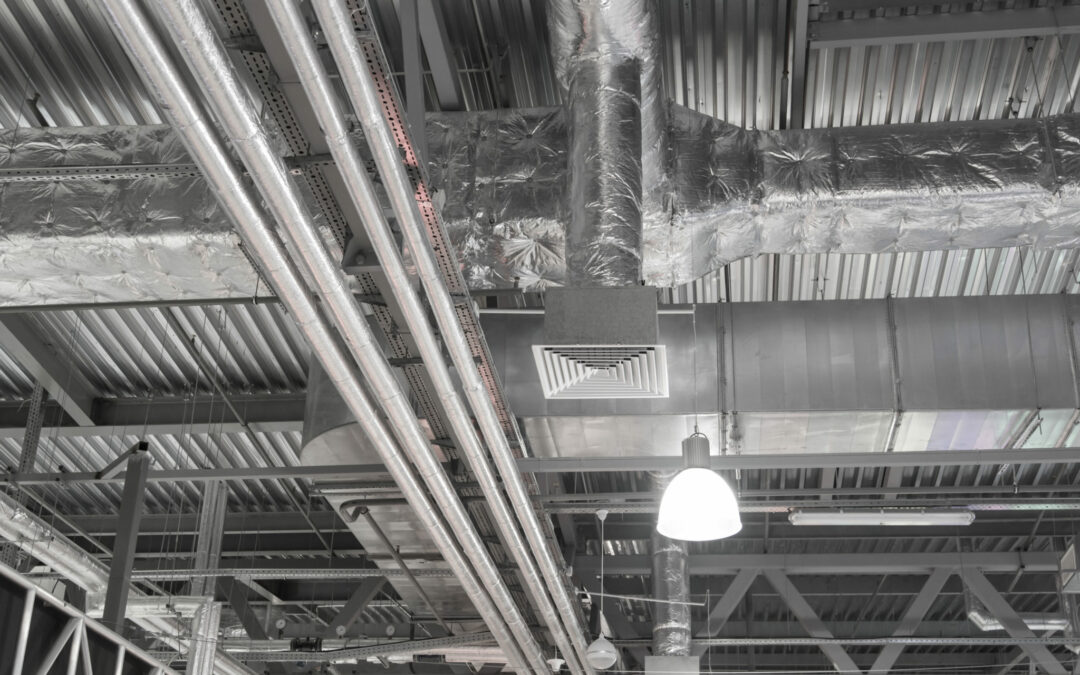Ductwork is the part of the HVAC system that we tend to think about the least even though it serves one of the most important purposes. Air ducts are the channels responsible for distributing cooled or heated air throughout the building, and without them, the rest of the HVAC system would be useless. There are a few different types of air ducts that can be used in a home or commercial building, and they each have their own advantages and disadvantages. The type of ductwork you should use depends on your HVAC needs and can be determined by an HVAC professional. There are two broad categories of ductwork: flexible and rigid.
Flexible Ductwork
Flexible ducts are typically round tubes made up of steel wire helixes covered in flexible but durable plastic. Most flexible ducts are also encircled by insulation to keep the air at the temperature it should be. This type of air duct is the easiest to install, and it is the second least expensive. Flexible ductwork is the best type of ductwork to use in tight or awkward spaces where rigid ductwork would be too difficult to install. Because these air ducts are flexible, they can bend around fixed structures to work in almost any space. However, flexible ducts are susceptible to kinks and bends that can restrict airflow and diminish the efficiency of the HVAC system. Airflow can also be somewhat reduced by the ridges on the inside of the ducts.
Another advantage of flexible ductwork is it is great for air quality. Because the ducts are made of plastic instead of the fiberglass that makes up some rigid ducts, no dangerous particles are released into the air, meaning fewer air pollutants to breathe in. This plastic is also resistant to mold and rust, which means air quality stays clean for much longer. Flexible ductwork has less potential for leaking air from your HVAC system than rigid ductwork, although it is more susceptible to being punctured.
Rigid Ductwork
The second category of ductwork is rigid ductwork. Rigid ducts can be different sizes and made from different materials, and they can be either rectangular or cylindrical. Because the ducts are rigid, they do not have the risk of kinks or bends restricting airflow and, unlike flexible ducts, they cannot be torn or punctured. However, rigid ducts cannot be easily used in tricky spaces. There are three main types of rigid ductwork: sheet metal ducts, fiberglass lined ducts, and fiberboard ducts.
· Sheet Metal Ducts: Sheet metal ducts are usually made of either galvanized steel or aluminum. Aluminum ducts are lightweight and very easy to install. Like flexible ductwork, sheet metal ducts are mold resistant because of their nonporous material, which allows for better air quality for a longer time. This type of ductwork is the most durable because it holds its shape and cannot be easily crushed. However, sheet metal ducts are more likely to experience leaks where two sections are joined.
· Fiberglass Lined Ducts: Some sheet metal ducts are lined with fiberglass on either the inside our outside of the duct. This lining provides insulation to keep the air at the correct temperature, to prevent the formation of condensation, and to muffle the sound of the HVAC system. The ability to muffle sound makes fiberglass lined ducts a popular choice in office and commercial buildings. The main disadvantage of this type of air duct is that the fiberglass can deteriorate over time and release fibers into the air, and breathing fiberglass particles can cause health issues after prolonged exposure. Fiberglass lined ducts are more difficult to keep clean because cleaning them can damage the lining and release more fiberglass particles into the air. This type of ductwork is also more prone to mold, mildew, and bacteria than flexible ducts or sheet metal ducts because of its porous surface. Fiberglass lined ducts should be cleaned by HVAC professionals to prevent the growth of contaminants and avoid the release of fiberglass particles.
· Fiberboard Ducts: Fiberboard is made up of compressed fiberglass fibers that have been sealed to prevent particles from entering the air. The outside of these boards is protected by a foil covering that acts as an air and moisture barrier. Fiberboard ducts are great insulators by themselves and do not require additional insulation. They are also the least expensive type of ducts to install. However, like fiberglass lined ducts, fiberboard ductwork is prone to growing mold and mildew. Also, the inside of fiberboard ducts is rough, which causes friction in the airflow and reduces the efficiency of the HVAC system.
HVAC Company in East Tennessee
Are you thinking about installing an air conditioning system in your home or business? Does your current ductwork need some maintenance? City Heating and Air Conditioning meets all your HVAC and air duct needs. Our HVAC experts can take a look at your space and determine which type of ductwork will best suit your specific needs. We also provide duct maintenance and cleaning services. Contact us today at 865-938-1005 or on our website.

